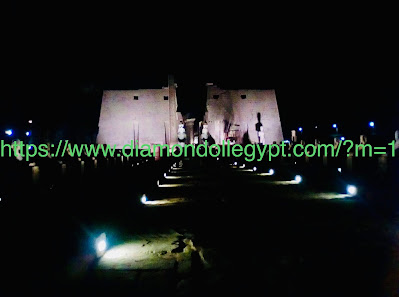Who built this temple?
This temple was built for the god Amun, the sacred animals of the god Amun are rams and lion, where the head of a lamb represents the god Amun and Wisdom, and the body of a lion represents strength.
This temple starts from the way of rams.
On either side of the road are 40 gigantic stone statues with Rams heads.
Why symbolize the path of rams to the God Amun ?
Because the ram is a symbol of life and reproduction.
Therefore, the ram is used to represent the god Amun, which symbolizes reproduction and growth.
Several small statues of Ramses II are carved under the ram’s head.
Rams Road is the road connecting Luxor Temple to the temple of Karnak, which began from the shore a spacious street, surrounded by Sphinxes’ statues, found in the temples of Karnak represented in the form of a Sphinx with a ram head. The ram here symbolizes the god Amun, perhaps to protect the temple and highlight its axis.
Naming
The ancient Egyptian on this road was called “ WAt-nTr Nasr “ in the sense of the way of God, the rams’ road in the temples of Karnak was known as “ Ta Mit Rahent “. And translate them by the rams way as well.
The History
The ram, a symbol of the God Khnom, one of the main gods in the ancient Egyptian religion. It is creator god who made mankind on the pottery wheel. According to the ancient Egyptian religion, it was surrounded by these rams flower basins and streams of water to irrigate it and in the middle of a rectangular floor dimensions of 120 in 230 cm of sandstone to facilitate walking and between each statue and a gap statue estimated at 4 meters in addition to what Queen Hatshepsut mentioned on the walls of her red arched in the cabbage.
More than 5,000 years ago, the Kings of Pharaonic Egypt in Thebes built the rams road( Sphinx road ), a road that used to connect Luxor and Karnak Temples to the holy processions of kings and gods in the celebrations of the feasts of the Obet of each year.
The king would march at the front of the procession, then he was followed by the high-ranking ministers, high priests and statesman behind the sacred boats that carried statues of the gods, while the people of the people lined up on both sides of the road, dancing and playing in joy and happiness.
The construction of this road began king Amenhotep III, who began the construction of the temple of Luxor. The greatest share in the implementation of this road black to King Nekhtenbo I, founder of the 30 Pharaonic dynasty ( The last dynasty of the era of the Pharaohs) is located along the road long 2.72 km and wide 700 meters 1200 statues these statues were carved from on block of sandstone erected on two bodies first in the form of the body of a lion and the head of a human being. The lion is one of the symbols of the sun god and the second in the form of a ram body and a ram head.
In Thebes, the country with the hundred doors, where the piles of gold shine, about four hundred men re passed in a military walk with their horses and their vehicles from each door of their huge doors. It was the administrative capital of upper Egypt during the reign of the 6th Pharaonic dynasty ( 3000-2100 B.C ). With its high disappeared position that reached the sky, only in the late 21st century B.C, it’s position was appeared when good princes managed to unite the country from the White Sea northward to the first waterfall to the south. When Egypt was invaded by Hyksos coming from the north, the two lands were United Upper and Lower Egypt, the seat of government then moved to Thebes, staying there for more than four centuries.

Comments
Post a Comment